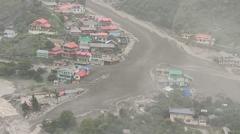The ongoing clashes represent a dangerous escalation of the India-Pakistan conflict, highlighting the increased volatility in Kashmir and the stakes involved.
# Escalation of Tensions: A Closer Look at the India-Pakistan Clashes

# Escalation of Tensions: A Closer Look at the India-Pakistan Clashes
Recent clashes between India and Pakistan have pushed the long-standing conflict over Kashmir to new heights.
The spark igniting the recent skirmishes between India and Pakistan was a terrorist attack on April 22 in Kashmir, escalating into a multi-day battle marked by advanced warfare technology.
On April 22, 2025, a terrorist attack in Indian-administered Kashmir served as the catalyst for renewed conflict between India and Pakistan. The Indian government's response, accusing Pakistan of providing a safe haven to militant groups, included a bold cross-border military campaign. For four consecutive nights, both countries engaged in fierce confrontations, unlike anything seen in recent half-century history, showcasing how sophisticated military technology has intensified hostilities.
As the firings began, India launched pre-dawn airstrikes, targeting installations deeper within Pakistan than it had dared to in decades. While the airstrikes were initially deemed successful, they soon devolved into airborne skirmishes between rival fighter jets, resulting in losses on both sides, including advanced Indian aircraft.
The second day saw heightened tensions as diplomatic efforts for de-escalation were underway. India reported intercepting a Pakistani counter-strike aimed at military assets across several border cities. In retaliation, India targeted critical military infrastructure, including air defense systems around Lahore—a move that analysts warned could further escalate the situation.
Media blackouts and prevailing disinformation campaigns have complicated efforts to ascertain the true extent of damages and casualties resulting from this renewed conflict. As both nations grapple with the fallout, the priority remains to prevent further escalation and seek diplomatic channels for resolution. The ramifications of this recent conflict will undoubtedly linger, reshaping the dynamics in the already fraught Kashmir region.
On April 22, 2025, a terrorist attack in Indian-administered Kashmir served as the catalyst for renewed conflict between India and Pakistan. The Indian government's response, accusing Pakistan of providing a safe haven to militant groups, included a bold cross-border military campaign. For four consecutive nights, both countries engaged in fierce confrontations, unlike anything seen in recent half-century history, showcasing how sophisticated military technology has intensified hostilities.
As the firings began, India launched pre-dawn airstrikes, targeting installations deeper within Pakistan than it had dared to in decades. While the airstrikes were initially deemed successful, they soon devolved into airborne skirmishes between rival fighter jets, resulting in losses on both sides, including advanced Indian aircraft.
The second day saw heightened tensions as diplomatic efforts for de-escalation were underway. India reported intercepting a Pakistani counter-strike aimed at military assets across several border cities. In retaliation, India targeted critical military infrastructure, including air defense systems around Lahore—a move that analysts warned could further escalate the situation.
Media blackouts and prevailing disinformation campaigns have complicated efforts to ascertain the true extent of damages and casualties resulting from this renewed conflict. As both nations grapple with the fallout, the priority remains to prevent further escalation and seek diplomatic channels for resolution. The ramifications of this recent conflict will undoubtedly linger, reshaping the dynamics in the already fraught Kashmir region.




















